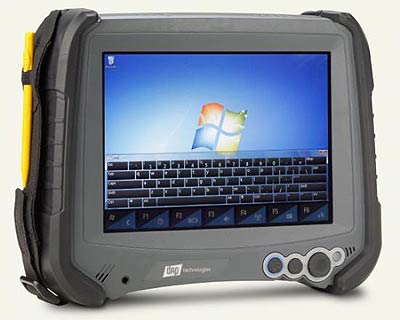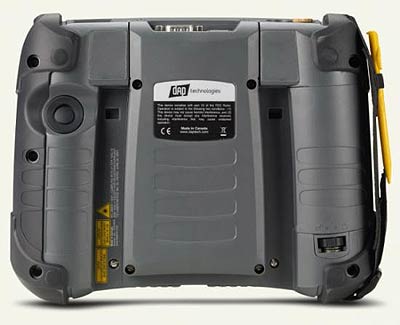|
DAP Technologies M9010
Latest rugged DAP full-screen tablet uses next-gen Intel Atom and communication technologies, runs both Windows Embedded and Windows CE
(by Conrad H. Blickenstorfer)
On March 22, 2011, DAP Technologies announced the rugged M9000 tablet computer. This follows DAP's announcement of their M2000 and M4000 series of rugged handhelds, and is part of the company's revamping/restructuring of its entire lineup of rugged mobile technology with a more consistent naming scheme.

As is always appropriate when things get reshuffled, a bit of background information: while the M9000 is a new product with significant new technology and interesting new features, the platform itself is an extension of the existing M8910 tablet, which began life as the Kinysis 8900VS in the summer of 2009. And the Kinysis used the same body and design as DAP's previous 8800 tablet. Part of this rapid succession of products is due to internal discussion as to whether this sort of product should use Windows CE or standard Windows, and in part also due to the inevitable advancement of technology.
So here's what likely happened, and how DAP arrived at the M9000 Series: DAP has a long history of designing and manufacturing rugged, workman-like, reliable Windows CE based mobile computers, including full tablets and tablets with half-size screens and an integrated keyboard. The addition of the Kinysis/M8910 represented DAP's move to make standard Windows available in its popular rugged full-screen tablet. Why not just run Windows on the older CE8800 model? Because that device's Marvel XScale processor did not support standard Windows, and so DAP used a 500MHz AMD Geode LX800 processor to run an embedded version of Windows on the Kinysis/M8910. Unfortunately, while the Geode was a very workable processor, it was also pretty much at the end of its life and had widely been replaced by the emerging Intel Atom processor platform. Which meant that the new Kinysis began life saddled with dated processor technology.
The new M9010 changes all that. It's based on the brand-new 1.3GHz Intel Atom E660T chip that very nicely combines new technology with good performance and great efficiency, and its "embedded" status means the chip will be around for years to come. Better yet, it can run both Windows CE and Windows Embedded, which means DAP Technologies can offer a nice, state-of-the-art rugged tablet no matter which of the two Windows platforms a customer's applications are running on.
That all said, let's take a look at the M9010: it's a compact, rugged tablet with a footprint of 9 x 7.2 inches (same general size as a netbook), a thickness of about 2.3 inches, and a weight just under three pounds. The resistive touch display measures 7.0 inches diagonally and offers WVGA 800 x 480 pixel resolution. That's a lot when you run Windows CE apps, though not that much when you run Windows Embedded, but still enough. The screen is outdoor-viewable and significantly brighter than those used in the older models (550 nits now). And thanks to an accelerometer, the display can automatically switch from landscape to portrait.
Like all DAP handhelds, the M9000 is ultra-rugged and highly configurable via its sealed expansion bay that can accommodate various ports, modules and interfaces. So while the basic tablet only has a minimum of onboard ports (USD and serial), you get more via dock, and more yet via the multi-I/O expansion slot.

DAP, however, added even more interesting features to the new M9000. There is, for example, integrated ZigBee wireless technology, a low-power IEEE 802.15.4-2003-based sensor technology increasingly used for everything from smart-grid power management to home and building automation (read Wiki entry on ZigBee). On the wireless side, DAP sprang for not only Bluetooth v2.1 and comprehensive 802.11a/b/g/n WiFi, but also Gobi 3000. Gobi provides total carrier and wireless technlogy independence, and also includes GPS. Finally, while the M8910 was already tough, the M9010 is tougher yet, now able to withstand multiple drops from six feet. The operating temperature range is a very wide -4 to +122 degrees Fahrenheit, and the device carries the prestigious IP67 sealing, which means it is both dust and waterproof.
While the older Windows CE and Windows Embedded tablets remain in the lineup, it seems pretty clear that the new M9000 line represents DAP's future in this category, and a very promising future it appears to be.
|
|
|
 Specifications DAP M9010 Specifications DAP M9010
|
|
Status
|
Added 03/2011, updated 04/2013, 12/2013
|
|
Form-factor
|
Rugged mobile tablet
|
CPU Speed
|
Intel Atom E660T 1.3 GHz
|
OS
|
Windows Embedded Standard 7
|
RAM
|
2GB DDR2 SDRAM
|
Storage
|
16/32/64GB solid state disk
|
Card slots
|
1 SDHC Card (up to 32GB)
|
Display type
|
Sunlight-viewable TFT
|
Display size/res
|
7.0 WVGA (800 x 480 pixels; 550 nits backlight)
|
Digitizer/pens
|
Passive touch screen, hardened (shock and scratch resistant)
|
Keyboard/keys
|
on-screen
|
Navigation
|
touch
|
Housing
|
plastic/metal
|
Operating Temp
|
-22° to 122°F (-30° to 50°C)
|
Sealing
|
IP67 (3.3 foot immersion)
|
Vibration
|
MIL-STD-810G
|
Shock
|
Multiple 6-foot drops onto concrete
|
ESD
|
15 kV air discharge, 8 kV direct discharge
|
Size (WxHxD)
|
9.0 x 7.3 x 2.3 inches (230 x 185 x 60 mm)
|
Weight
|
2.96 lbs (1.35kg)
|
Power
|
Primary rechargeable, hot-swapable 7.4V/3,100 mAH Li-Ion, secondary 7.4V/3,100mAH Li-Ion for total of 46 watt-hours
|
Sensors
|
Light sensor, accelerometer
|
Interface
|
1 x RS232, 1 x USB 2.0, 1D x laser, speaker, audio, 5mp camera with flash; via dock connector: 1 RS232, 1 USB 2.0, 1 RJ45 LAN; via multi-I/O expansion slot: 2 USB 2.0, 1 CAN bus 2.0, 1x SDVO, 2 RS-232
|
Wireless
|
Bluetooth 802.15 Class II V2.1 + EDR, 802.11a/b/g/n, Gobi 3000: (CDMA, EVDO, UMTS, GSM, GPRS, EDGE, DTM, HSPA, 3G: 14.4/5.76 Mbps DOrB: 9.3/5.4 Mbps); ZigBee
|
List price
|
inquire
|
Contact
|
DAP M9010 page
|
Brochure
|
 DAP M9010 brochure DAP M9010 brochure
|
|
 Definitions/Primers Definitions/Primers
|
|
Active vs passive digitizers
What does "rugged" mean?
Rugged Specs Primer
FIPS 201
Intrinsic Safety
NEMA Ratings
NVIS standards
IEC 60601
IP Rating
RFID
RFID vs. Bar Code
RoHS
Outdoor-readable screens '07
PCI compliance
UL 1604
MIL-STD-3009
|
|



